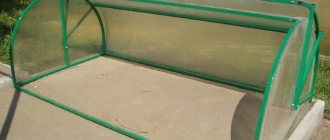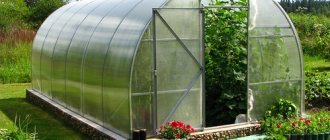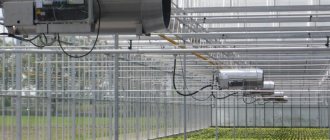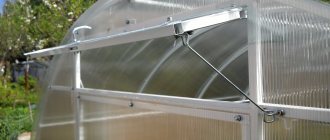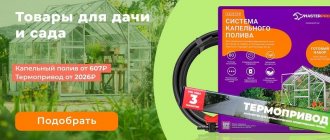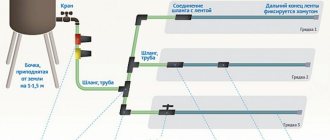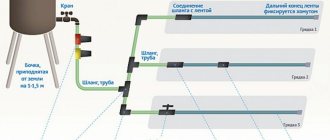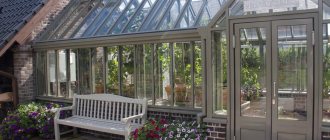Maintaining Humidity
For optimal growth and fruiting of many crops (tomatoes, cucumbers, mushrooms, many others), it is recommended to maintain a certain level of humidity. Maintaining the required humidity increases yield and minimizes the risk of disease development.
However, in closed ground conditions (in a greenhouse, for example), the required humidity will not be maintained by itself during the season, much less all year round. Depending on the time of year, weather, solar activity, watering schedule and many other factors, humidity will vary widely.
This means that the task of the prudent owner is to take control of humidity into his own hands.
You can get rid of high humidity with the help of ventilation, but you can get rid of low humidity only by installing a fog formation system, which, by spraying water in the form of fog, increases the humidity to a predetermined level.
DIY water mist
Today we’ll talk about the fogging system in the garden plot. “And I’m going, and I’m going after the fog”... For some, fog is romance, but for others, on the contrary, it’s dank autumn slush. How differently the same natural phenomenon is perceived! In the city it is damp. And in nature, the morning fog is an opportunity to run through the dewy grass.
For a landscape designer, a fogging system is an opportunity for unusual garden decoration. But for a gardener, it is more important to create an optimal microclimate in a greenhouse or recreation area.
The fogging system is based on the supply of water under pressure through special nozzles. The minimum nozzle opening is 0.2-0.6 mm. The smaller the nozzle diameter, the denser the fog cloud is formed. The size of water microparticles is from 3 to 7 microns
- Using a fog generator, the humidity level is maintained. The gardener, turning on the system, regulates the decrease in air temperature. This is what creates the optimal microclimate for plants. The higher the humidity, the lower the temperature.
- Through the humidification system, you can supply a solution of micro and macro fertilizers for foliar feeding of plants. Therefore, it will be beneficial for growth and development.
- If necessary, solutions of fungicides and insecticides are supplied to the system. This will protect the plantings from diseases and pests. At the same time, uniform distribution of drugs is guaranteed.
Temperature maintenance
In summer, due to solar activity, the temperature outside can reach high values, and in enclosed spaces even higher. High temperatures can harm crop yields both during the flowering period and during the growing season and fruiting.
It is possible and even necessary to lower the temperature in the greenhouse by installing shading and ventilation systems, but in addition to them, a fogging system . The temperature reduction effect is achieved through the evaporation of atomized fine water.
Reviews of fog generators
Domestic manufacturers produce one-piece fogger installations only for industrial greenhouses. The private market is covered by plastic units from Israel and China. They belong to the budget category. On forums, gardeners share their personal experiences of using foggers for greenhouses.
Vladimir from Samara notes a useful property of the installations: in a number of situations, water should not get on the foliage and flower petals. A properly configured fogger ensures this, but only in greenhouses with a height of at least 3.5-4 m. Andrey (Rostov) advises taking foggers with a water flow rate of at least 12 l/h. Otherwise, instead of fog, large drops are obtained. Even a powerful pump will not save you.
Probably, experienced summer residents will question the need to purchase a fogger. You can get a harvest without it. However, practice shows that generating fog in a greenhouse will increase the number of fruits, speed up their ripening, and save plants from stressful heat.
I. High pressure fogging
It is characterized by very high pressure in the main line with foggers - above 20 atmospheres. All components of such a system are designed for high pressure; fog nozzles are most often made of brass. To create such pressure, it is necessary to use a special pumping station and comply with very high water filtration requirements. In addition, high blood pressure is dangerous if handled carelessly.
High Pressure Fogging Nozzle
High pressure fogging pump
The fog obtained in such a system corresponds to real fog due to the very small size of the resulting water droplets, but due to the use of high pressure, such equipment and components are very expensive and are used in large industrial greenhouses.
How to calculate the number of injectors
For different areas and heights of the greenhouse, different numbers of spraying devices will be required. Farmers' recommendations:
- Calculate the volume of air in your greenhouse: the difference between the total volume and the space occupied by beds, equipment and plants.
- Determine a stable humidity level for your greenhouse.
- Calculate the critical and average temperature values indoors. They depend on the orientation, illumination of the greenhouse on the site, its area, transparency of the covering material, the tightness of the structure and ventilation methods, and the ability to accumulate heat.
- The physical parameter of energy consumption for water evaporation is 0.7 kW/h per 1 kg of water. Taking this into account, calculate how much water you need to spray in your greenhouse to lower the temperature from +35 °C to +20 °C.
The higher the humidity indicator, the faster the energy efficiency of the transition of moisture from liquid to vapor decreases. The final value will indicate the power level for purchasing a pumping station. Take this as a starting point when choosing the number and diameter of injector nozzles. Afterwards it is easier to calculate the length of the water pipe.
II. Low pressure fogging
There is a whole class of equipment for producing fog, operating at low pressure - about 2-2.5 atmospheres.
Of course, the resulting water suspension from such systems cannot be called full-fledged fog. This is not a mist, but rather very fine droplets, but for most applications this is sufficient, especially when used in medium and small greenhouses.
Fogger for 4 nozzles
Fogger 1 nozzle
Low pressure, conventional water filtration as for drip irrigation systems, standard pumps and controllers - all this equipment is quite reasonably priced.
Therefore, any greenhouse owner can buy and assemble a low-pressure fogging unit.
What you need to assemble a low pressure fogging system:
- Controller – controls the operation of the system according to a schedule or sensors,
- Pumping station – provides the necessary pressure in the fogging line,
- Filter – purifies water and protects nozzles from clogging,
- Water supply line – ensures water distribution throughout the greenhouse to the nozzles
DIY fogging system for design and greenhouse
A fogger, fogger or evaporative cooling system is a modern climate system for greenhouses and greenhouses of various sizes. Its task is to create artificial steam and regulate the level of humidity in accordance with the needs of the planted crops. Thus, the device brings the atmosphere inside a closed space closer to natural.
Why a fogger is useful for greenhouses:
- Accelerates the development of seedlings. Reduces the need for watering.
- Cools the atmosphere in extreme heat. The fogger also protects the soil and vegetation from drying out.
- Helps fruit crops and shrubs develop properly when planted by cuttings. Until roots of sufficient length appear, they absorb water through the leaves. In this case, it is especially important that the moisture is supplied in small drops, in the form of spraying.
- Simplifies the process of treating beds with agents against diseases and pests. Moisture accelerates the absorption of substances.
The fogger disperses clean water in the form of micrometric droplets. They are several times smaller than the thickness of a human hair. Moisture does not stagnate or dry out on the leaf plates, exposing the greens to the risk of burns, but evaporates almost instantly. Bottom line: the leaves are always moist, the temperature is stable and does not exceed a safe level for plants.
Attention! Good foggers for greenhouses allow the owner to program a daily humidification schedule and operate the system automatically.
The farmer receives a crop that has not been subjected to stress during the growing process. Crops will bear fruit earlier. Vegetables and berries will receive the necessary basis of nutrients and will not lose their taste and aroma properties. These qualities are especially important for gardeners who grow crops for sale.
How the system works
Main elements of the fogger:
- Piston pump (pumping station). Power - from 2 kW. Creates high pressure in the water supply system (100 Bar and above). This allows fog to be generated from ultra-fine droplets. Most often, models with an electric drive and a crankshaft are used in foggers for greenhouses.
- Spray nozzles. The most effective are those that spray the smallest droplets. For example, sprinklers.
- Water supply line and wiring inside the greenhouse.
- Control Panel. Particularly important for large industrial greenhouses. But it will also come in handy on a small farm: it will save the owner’s time and effort.
The components of the fogger panel constantly take physical measurements and adjust them as necessary. In addition to humidity, temperature indicators can be measured and adjusted. Sometimes even spray chemicals. What is included in such a fogger panel:
- the control unit itself with sensors, buttons and a socket (for connecting the pump);
- hygrometer - humidity meter;
- controller - correlates hygrometer data with a given humidity level, and, if necessary, increases or decreases the intensity of pumping water supply;
- fans - help to distribute fog evenly throughout the greenhouse or greenhouse (optional element).
Essential elements
Now let's talk about what the systems we describe consist of. In particular, let's look at their key devices.
Pump
In this photo you can see a 3.5 kW pump
This element creates high pressure. Inside it there is a piston that allows you to create a pressure of more than one hundred bar. It is this value that ensures the creation of an ultra-fine, quickly evaporating mist.
Valve blocks are usually made from metals such as aluminum, steel, cast iron or brass. Models with crankshaft and electric drive are used. It must have a power of at least 2 kW .
Fogging controller
The automatic mode of operation of the fogging system is ensured by the correct choice of controller. The controller must ensure the necessary task of maintaining temperature, humidity, etc.
The main feature of the controller for fogging systems is the ability to turn on the water supply for seconds . Since fogging is turned on as a rule for 10-15 seconds.
In fogging systems, only specific controllers can be used, since conventional timers are not capable of turning on the water supply for seconds . For example, this function is available:
- some models of Gewa-Baccara timers with index W (Window)
- automatic watering controllers f. Irritrol Junior series .
Junior Max controller
Special Window timer f. Baccara-Gewa LLc.
Importance of fogger for plants
A natural example of a natural air conditioner is a waterfall. The same principle is inherent in fogging systems. High-pressure water is turned into jets of mist that remove heat from the air.
Industrial fogger for greenhouse
Foggers have been used in industrial greenhouses and winter gardens with exotic plants for a long time. The systems are also popular in the field of landscape design and site development. Clouds of fog look gorgeous around artificial ponds or alpine slides. And equipping the veranda with such a system will allow you to calmly enjoy your holiday in any heat.
Fog generator in landscape design
Many summer residents believe that foggers are an unnecessary luxury for small farm greenhouses, because cucumbers and tomatoes can be grown without them. However, there are a number of advantages to using it that are quite difficult to refuse.
- Thanks to the installation, a microclimate appears in the greenhouse that is suitable for exotic and moisture-loving plants. For example, cucumbers love high humidity.
- Seedlings develop much faster, because they absorb moisture not only with their roots, but also with their leaves.
- It has been noticed that flowers when grown with a fogger acquire brighter colors.
- Through the installation, you can effectively and economically spray plants with water-soluble fertilizers and agents that protect against diseases and pests.
- If you turn on the system on a hot summer day, the temperature in the greenhouse will drop by about 15 °C. Therefore, the device is also called a water conditioner.
The disadvantage of the system is that it can be used mainly in the summer. In winter - only in well-heated rooms.
The pipe with fittings is mounted at a height of at least 2 meters
Fogging pump
Almost any low pressure fogging pump can be used that provides the required water flow and pressure for the fogging nozzles. It is better to use pumping stations with an expansion tank - a receiver, since frequent switching on and off is harmful for a pump without a receiver.
pumping station with receiver
To stabilize the output pressure, a pressure reducer can be installed after the station.
Water supply line
As a main line for low-pressure fogging systems, you can use a polyethylene water pipe (HDPE) or a blind drip PVC pipe .
Depending on the type of line used, the method of connecting the fog nozzles to the line also changes. To do this, use appropriate adapters.
Adapter with a spike for connecting to a PVC pipe line
Adapter with thread for inserting into HDPE line
Threaded adapter
DIY fogging system
Today we’ll talk about the fogging system in the garden plot. “And I’m going, and I’m going after the fog”... For some, fog is romance, but for others, on the contrary, it’s dank autumn slush. How differently the same natural phenomenon is perceived! In the city it is damp. And in nature, the morning fog is an opportunity to run through the dewy grass.
For a landscape designer, a fogging system is an opportunity for unusual garden decoration. But for a gardener, it is more important to create an optimal microclimate in a greenhouse or recreation area.
The fogging system is based on the supply of water under pressure through special nozzles. The minimum nozzle opening is 0.2-0.6 mm. The smaller the nozzle diameter, the denser the fog cloud is formed. The size of water microparticles is from 3 to 7 microns
- Using a fog generator, the humidity level is maintained. The gardener, turning on the system, regulates the decrease in air temperature. This is what creates the optimal microclimate for plants. The higher the humidity, the lower the temperature.
- Through the humidification system, you can supply a solution of micro and macro fertilizers for foliar feeding of plants. Therefore, it will be beneficial for growth and development.
- If necessary, solutions of fungicides and insecticides are supplied to the system. This will protect the plantings from diseases and pests. At the same time, uniform distribution of drugs is guaranteed.
In the garden and on the terrace
- To clean the air from dust particles.
- Cooling the air in hot weather.
- In addition, it is difficult for insects to move in humid air: their wings get wet. Therefore, you will be able to relax on the open terrace, but mosquitoes and mosquitoes will not be able to bother you.
- When cultivating mushrooms, in particular oyster mushrooms. There will be no need to spray the mycelium to humidify the air.
- Creating a foggy cloud on alpine hills and near artificial reservoirs. It has been observed that flowers grown using artificial fog have brighter colors.
Attention! The greatest effect is achieved at a temperature of 30-40˚С. Namely, exceeding +30˚С has a detrimental effect on the viability of pollen of vegetable crops.
Therefore, fog will increase fruit production.
Of course, you can purchase a fogger in online stores or at specialized retail outlets. But the price of the product makes you think. The minimum amount starts from 55 thousand rubles.
“Advanced” greenhouse growers recommend making a fogging system with your own hands. To do this, you need to have basic knowledge and skills in plumbing work and, of course, your desire.
High Pressure Fogging System
At a system pressure of 20 bar, it is possible to obtain a full-fledged fog cloud with water microparticles of 3-5 microns.
Consumables
So, to build a structure using high pressure you need:
- copper or aluminum, but in no case iron or plastic, a tube with a diameter of 4 to 6 mm and a length corresponding to the size of your greenhouse;
- pressure control valve;
- tees - fittings, for a standard greenhouse you will need 35-40 pieces;
- corner fittings;
- for each fitting, purchase nozzles sold at any hardware store;
- fine water filter;
- pump;
- controller-timer for turning on the water supply.
System installation
After purchasing the above materials, proceed directly to assembly. Now it all depends on your imagination, but you can adhere to the following algorithm:
- You need to start by assembling the main line with fittings. Place the fittings at an equal distance from each other, but no more than 50, no less than 70 cm.
- The valve for regulating the pressure in the system is installed on the main line. It will be located after the filter.
- We attach a nozzle to each fitting.
- Then we attach this structure along the perimeter to the ceiling of the greenhouse. We place a corner fitting on the bends. This is necessary so that the pipe does not bend and nothing interferes with the movement of water through the system. For fastening, you can use a thin metal cable or twine on rollers.
- It is recommended to install a plug at the end of the pipe, but our compatriots came up with know-how. We attach a tap and a rubber tube to the end of the pipe, which we take “overboard” of the greenhouse. This is necessary to quickly and efficiently flush the system after working with fertilizers, disease control agents, etc.
- We install a fine water filter.
- And the final part of assembling your structure is connecting the pump. We install the distribution pipes after the filter.
Important! No matter how clean the water is in the water supply, well or Artesian, a filter must be installed. Otherwise, the injectors will clog and quickly fail.
Systems using high pressure produce the finest fog cloud. It looks impressive in garden design. Used in industrial greenhouse complexes. But even home-made equipment will cost quite a hefty sum due to the high cost of components.
Maybe you are interested in a drip irrigation system? You can get more detailed information about such a system from my colleague’s article by clicking on this link .
Low pressure fogging system
A do-it-yourself fogging system using low pressure is several times cheaper. Water microparticles, of course, will be larger, 7-10 microns. Therefore, it is more of a water mist, but is quite suitable for use in small greenhouses.
Required materials and components:
- A controller that allows you to turn on the water supply for a short time, literally, for a few seconds, up to a quarter of a minute.
- Pumping station for supplying water to a system with a receiver. Because a conventional pump simply cannot withstand frequent on-off switching.
- Polyethylene water pipe or blind drip PVC tape.
Low pressure spray nozzles made of stainless steel. Spray diameter 0.2-0.6 mm. The diameter of connection to the hardware connector is 6 mm. Pressure from 5 to 20 bar. There is an anti-drip valve. Thus, when the pump is turned off, water from the supply pipe does not drip through the nozzle.
The operating procedure is similar to assembling a high pressure system.
This is not to say that organizing fogging is an easy task. But, if you have a little technical knowledge and skills, it is quite doable.
Likes: 15 Dislikes: 0
Galina Stepanova
I love learning something new, communicating with people. After all, every person is a whole world. I put my knowledge and thoughts into the articles. I hope that my articles will be useful. I would really like to know the readers’ opinions on the topics of publications. Perhaps someone has a different point of view.

